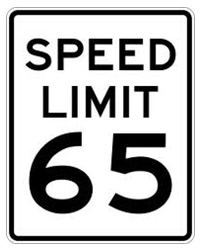 California “Basic Speed Law” indicates that you may never drive faster than is safe for current conditions. For example, if you are driving 45 mph in a 55 mph speed zone during a dense fog, you could be cited for driving “too fast for conditions.”
California “Basic Speed Law” indicates that you may never drive faster than is safe for current conditions. For example, if you are driving 45 mph in a 55 mph speed zone during a dense fog, you could be cited for driving “too fast for conditions.”
Regardless of the posted speed limit, your speed should depend on:
- The number and speed of other vehicles on the road.
- Whether the road surface is smooth, rough, graveled, wet, dry, wide, or narrow.
- Bicyclists or pedestrians walking on the road’s edge or crossing the street.
- Whether it is raining, foggy, snowing, windy, or dusty.
Maximum Speed Limit

The maximum speed limit on most California highways is 65 mph.
- You may drive 70 mph where posted. Unless otherwise posted, the maximum speed limit is 55 mph on two-lane undivided highways and for vehicles towing trailers. Other speed limit signs are posted for the type of roads and traffic in each area. All speed limits are based on ideal driving conditions. Construction zones usually have reduced speed zones.
- Driving faster than the posted speed limit or driving faster than safe for current conditions on any road is dangerous and illegal. High speed increases your stopping distance. The faster you go, the less time you have to avoid a hazard or collision. The force of a 60 mph crash is not just twice as great as a 30 mph crash —- it’s four times as great!
- The urban driving environment is typically more challenging to the novice driver because there are more stimuli to be sorted and reacted to. Reducing speed allows more time to see the details of the urban driving environment such as pedestrians, road hazards and traffic flow. It also allows time to analyze what you see and predict what might happen, react to any hazards that might require quick reflexes, execute decisions to safely change directions and avoid hazardous situations. 50% of all traffic violations involve speeding. Many of these occur in urban areas.
- There is no minimum speed limit in California, but the law states that: “No person shall drive so slowly or stop on the roadway that may impede traffic or block the normal and reasonable movement of traffic.” You can be cited if you are stopped for doing this.
- You should reduce your speed when:
- Traffic is dense.
- Near shopping centers, parking lots and in downtown areas.
- When you see brake lights on several cars ahead.
- Driving on narrow bridges and in tunnels.
- When approaching toll plazas.
- Near schools, playgrounds and on residential streets.
- There are special speed limits that are to be obeyed even if there is no sign erected. Conviction of speeding when driving in these special areas is based on proof that the driver was unsafe and negligent.
- Railway crossings
- Blind intersections
- Alleys
- Residential districts
- Schools
- Bridges
- Business districts
- You can assume that the speed limit is 25 miles per hour in any business or residential district unless posted otherwise. When passing a school when children are present and when passing a senior center with a “senior” warning sign, the speed limit is also 25 mph unless otherwise posted. Sometimes lower speed limits are posted in the general vicinity of schools in addition to the school itself. Specially marked crosswalks and five-sided signs warn that you are approaching or are in the presence of a school.
 Click for more information on Laws and Rules of the Road: Speed Limit http://www.dmv.ca.gov/pubs/hdbk/speed_limits.htm
Click for more information on Laws and Rules of the Road: Speed Limit http://www.dmv.ca.gov/pubs/hdbk/speed_limits.htm
You should reduce your speed rather than “ride the brake.”
Covering the brake pedal to improve reaction time is recommended when:
- You are passing parked cars, as they may pull out in front of you or open their door
- You see brake lights ahead meaning that traffic is coming to a stop
- You are approaching signal lights- look for traffic build up at the intersection and for flashing crosswalk lights, because these indicate that the light is about to change.
CVC Code: Established Speed Laws
CVC 22400: Minimum Speed Law
(a) No person shall drive upon a highway at such a slow speed as to impede or block the normal and reasonable movement of traffic, unless the reduced speed is necessary for safe operation, because of a grade, or in compliance with law.
No person shall bring a vehicle to a complete stop upon a highway so as to impede or block the normal and reasonable movement of traffic unless the stop is necessary for safe operation or in compliance with law.
(b) Whenever the Department of Transportation determines on the basis of an engineering and traffic survey that slow speeds on any part of a state highway consistently impede the normal and reasonable movement of traffic, the department may determine and declare a minimum speed limit below which no person shall drive a vehicle, except when necessary for safe operation or in compliance with law, when appropriate signs giving notice thereof are erected along the part of the highway for which a minimum speed limit is established.
Subdivision (b) of this section shall apply only to vehicles subject to registration.
CVC 22406: Maximum Speed for Designated Vehicles
No person may drive any of the following vehicles on a highway ?at a speed in excess of 55 miles per hour:
- A motor truck or truck tractor having three or more axles or any motor truck or truck tractor drawing any other vehicle.
- A passenger vehicle or bus drawing any other vehicle.
- A school bus transporting any school pupil.
- A farm labor vehicle when transporting passengers.
- A vehicle transporting explosives.
- A trailer bus
CVC 22406.1: Commercial Motor Vehicle Driver: Penalties
- A person who operates a commercial motor vehicle, as defined in subdivision (b) of Section 15210, upon a highway at a speed exceeding a posted speed limit established under this code by 15 miles per hour or more, is guilty of a misdemeanor.
- A person who holds a commercial driver’s license, as defined in subdivision (a) of Section 15210, and operates a noncommercial motor vehicle upon a highway at a speed exceeding a posted speed limit established under this code by 15 miles per hour or more, is guilty of an infraction.
- A violation of either subdivision (a) or (b) is a “serious traffic violation,” as defined in subdivision (p) of Section 15210, and is subject to the sanctions provided under Section 15306 or 15308, in addition to any other penalty provided by law.
- This section shall become operative on September 20, 2005.
CVC 22413: Decreasing Speed Limit on Grades
- Whenever a local authority determines upon the basis of an engineering and traffic survey that the prima facie limit of 25 miles per hour is more than is reasonable and safe on any portion of a street having a grade in excess of 10 percent, the local authority may by ordinance determine and declare a maximum limit of 20 or 15 miles per hour, whichever is found most appropriate and is reasonable and safe.
- The declared maximum speed shall be effective when appropriate signs giving notice thereof are erected upon the street.
 Click for more information about California Vehicle Code (CVC)
Click for more information about California Vehicle Code (CVC)
http://www.dmv.ca.gov/pubs/vctop/vc/tocd11c7a2.htm

